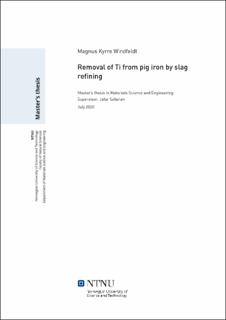| dc.contributor.advisor | Safarian, Jafar | |
| dc.contributor.advisor | Tang, Kai | |
| dc.contributor.author | Windfeldt, Magnus Kyrre | |
| dc.date.accessioned | 2021-09-28T18:12:14Z | |
| dc.date.available | 2021-09-28T18:12:14Z | |
| dc.date.issued | 2020 | |
| dc.identifier | no.ntnu:inspera:59547306:18291334 | |
| dc.identifier.uri | https://hdl.handle.net/11250/2785289 | |
| dc.description.abstract | I dette prosjektet undersøkes muligheten for bruk av slaggraffinering for å fjerne titan fra karbonholdig råjern, som en del av ENSUREAL-prosjektet for bærekraftig produksjon av alumina. Slaggen som brukes til raffinering er CaO-Al2O3-Fe2O3. Systemets likevekt undersøkes ved 1600 °C ved bruk av termodynamisk modellering og eksperimentelle raffineringsforsøk. Beregninger for modellen baserer seg på minimering av Gibbs energi og gjøres ved bruk av MS Excels problemløser, med data fra kommersiell termokjemisk programvare. Raffineringseksperimentene gjøres på syntetisk slagg og legeringer med varierende Ti- og Fe2O3-innhold som begge er produsert som en del av prosjektet. De resulterende materialenes struktur analyseres ved bruk av EPMA, og den kjemiske sammensetningen undersøkes ved bruk av XRF og LECO.
Modellen indikerer at både titan og karbon kan fjernes fra metallet ved at de reagerer med jernoksid i slaggen. Ved lavt Fe2O3-innhold forutsier den oksidering av titan foran karbon. De eksperimentelle resultatene støtter dette ved at titan hovedsakelig finnes i slaggen for alle prøver, og ved at karbonnivået i metallprøvene er betydelig lavere når slaggen inneholder mer Fe2O3. Beregningene gjort med modellen er ellers sammenlignbare med de fra kommersiell programvare. Noen uønskede TiC-partikler er også å finne i metallet når de inneholder mye titan og det brukes lite Fe2O3. Det konkluderes med at slaggraffinering er en lovende metode for å fjerne titan fra råjern. | |
| dc.description.abstract | This project studies the feasibility of using slag refining to remove titanium from carbon-containing pig iron, as part of the ENSUREAL project for sustainable alumina production. A CaO-Al2O3-Fe2O3 slag mixture is used for the refining. The equilibrium of this system is examined at 1600 °C by use of thermodynamic modelling and experimental refining tests. Calculations for the model are based on Gibbs energy minimisation, and are done using MS Excel's solver tool with data from commercial thermochemical softwares. Refining experiments are done using synthetic slag and alloys with varying amounts of Ti and Fe2O3, both of which are produced as part of the project. The structure of the resulting materials is examined using EPMA, and their content is determined using XRF and LECO.
The model suggests the removal of both titanium and carbon from the metal by reaction with iron oxide in the slag. At low amounts of Fe2O3 it predicts preferential oxidation of titanium. This is supported by the experimental results, as the titanium is found mostly in the slag phase in all samples, while carbon levels in the metal are significantly lower when more Fe2O3 is used in the slag. The calculations from the project model are comparable with those of commercial software. Some unwanted TiC particles are also found in the metal when Ti content is high and low amounts of Fe2O3 is used. It is concluded that slag refining is a promising method for removing titanium from pig iron. | |
| dc.language | | |
| dc.publisher | NTNU | |
| dc.title | Removal of Ti from pig iron by slag refining | |
| dc.type | Master thesis | |
